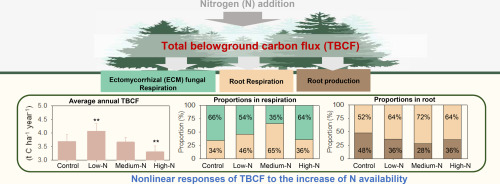当前位置:
X-MOL 学术
›
Sci. Total Environ.
›
论文详情
Our official English website, www.x-mol.net, welcomes your feedback! (Note: you will need to create a separate account there.)
Nonlinear responses of total belowground carbon flux and its components to increased nitrogen availability in temperate forests.
Science of the Total Environment ( IF 9.8 ) Pub Date : 2020-01-27 , DOI: 10.1016/j.scitotenv.2020.136954 Wenjing Zeng 1 , Jiangyong Zhang 2 , Lizheng Dong 1 , Wei Wang 1 , Hui Zeng 2
Science of the Total Environment ( IF 9.8 ) Pub Date : 2020-01-27 , DOI: 10.1016/j.scitotenv.2020.136954 Wenjing Zeng 1 , Jiangyong Zhang 2 , Lizheng Dong 1 , Wei Wang 1 , Hui Zeng 2
Affiliation

|
With the increased interest in allocating more carbon (C) belowground for C sequestration, total belowground C flux (TBCF) and its dynamics have become an important research topic. However, it remains uncertain whether TBCF responds nonlinearly to increased nitrogen (N) availability and how its main components (root and ectomycorrhizal (ECM) fungi) contribute to TBCF. We established a four-year N addition experiment with control, low-N, medium-N, and high-N fertilization treatments in a N-limited temperate forest in northern China. We measured TBCF and its three main components including root respiration, ECM fungal respiration, and root production. The involved edaphic and plant factors were also measured. TBCF showed a nonlinear response to the increasing amounts of N addition, accelerated by 10.37% in low-N addition and restrained by 10.29% in high-N addition. Contrasting patterns of the contributions of root respiration and ECM fungal respiration to TBCF implies different strategies of investment in roots and ECM fungi under the different N-availability statuses. The ratio of production and respiration in roots under N addition was nearly 1:2, which indicated that when soil N availability increases, roots prefer to lose C by overflow respiration rather than fix C in new biomass. The low-N addition increased TBCF by directly increasing root respiration and indirectly increasing coarse root biomass. The medium-N addition positively affected TBCF by increasing root respiration but this positive effect was cancelled out by the significantly negative effect of the increased soil total N concentration. The decrease in soil pH was the most effective pathway to decrease TBCF in high-N addition. Because of a large-scale reforestation program for C sink management in recent years, our findings of the nonlinear response of TBCF to different N fertilization treatments could provide insight for predicting belowground C sequestration potential and its response to atmospheric N deposition.
更新日期:2020-01-27

























 京公网安备 11010802027423号
京公网安备 11010802027423号